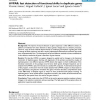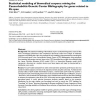439 search results - page 73 / 88 » Maximum entropy methods for biological sequence modeling |
BMCBI
2008
13 years 9 months ago
2008
Background: We present a novel method of protein fold decoy discrimination using machine learning, more specifically using neural networks. Here, decoy discrimination is represent...
BMCBI
2006
13 years 9 months ago
2006
Background: The imprint of natural selection on gene sequences is often difficult to detect. A plethora of methods have been devised to detect genetic changes due to selective pro...
JCB
2006
13 years 9 months ago
2006
A commonly used tool in disease association studies is the search for discrepancies between the haplotype distribution in the case and control populations. In order to find this d...
BMCBI
2006
13 years 9 months ago
2006
Background: The statistical modeling of biomedical corpora could yield integrated, coarse-to-fine views of biological phenomena that complement discoveries made from analysis of m...
JCB
2008
13 years 9 months ago
2008
Resolving the general organizational principles that govern the interactions during transcriptional gene regulation has great relevance for understanding disease progression, biof...


